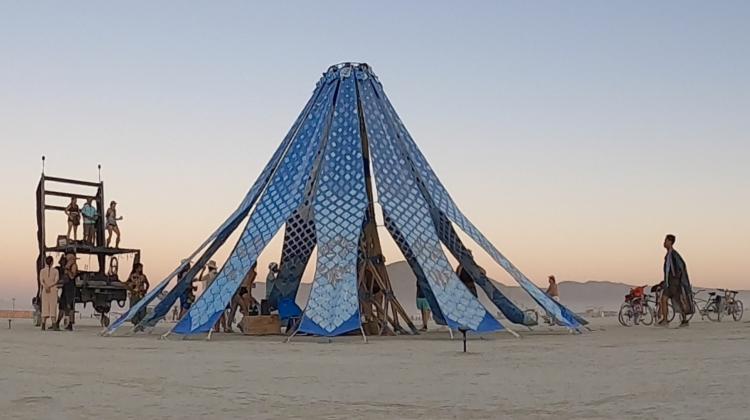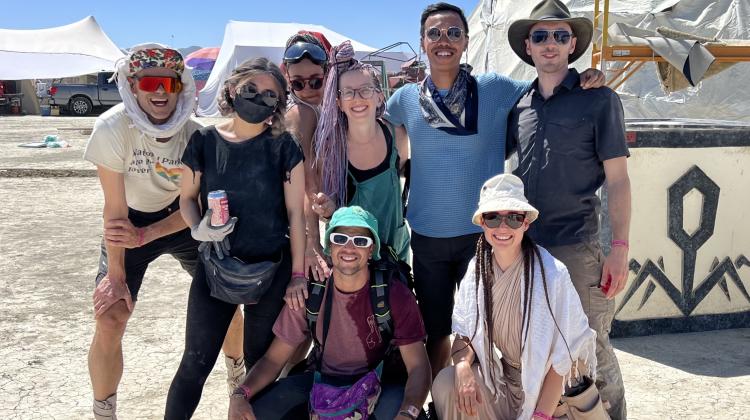Irmandy Wicaksono works at the intersection of technology, art, and science. He says MIT “is the place to explore these boundaries.”
By Maria Iacobo
How many people can say their career trajectory changed after dressing Lady Gaga?
While an intern for London-based Studio XO, Irmandy Wicaksono collaborated on a dress that featured an integrated bubble machine and an array of mechanical mirrors. He didn’t meet the client, Lady Gaga, until the fitting. Wicaksono says the experience of using his engineering skills with his love of art showed him that he could combine these two passions and forge a career.
“That’s how I got into wearable technology; through these mechatronic dresses for Lady Gaga,” says Wicaksono.
Now a PhD student, Wicaksono is blending technology — his undergraduate and master’s degrees are in electronic and electrical engineering — and media arts and sciences at the MIT Media Lab’s Responsive Environments group. His work with interactive textiles began with small projects, such as a knitted scarf that is also a keyboard, and grew to include larger items and household textiles.
His most elaborate and collaborative piece to date is an interactive structure. The Living Knitwork Pavilion debuted at Burning Man — a weeklong, large-scale event held in the Nevada desert and focused on community, art, and self-expression — in September. The yearlong project expanded Wicaksono’s understanding of structural engineering and provided an outlet to share some of the cultural images from his native Indonesia.
Wicaksono first attended Burning Man in 2022 and was overwhelmed with the experience: the community, the art, the “magical desert sunrises.” Intent on participating as an artist, he received a 2023 Black Rock City Honoraria arts grant. The project neatly dovetailed with his thesis: fabricating interactive textiles across scales. Knowing that building the structure and the logistics of transporting, assembling, and disassembling it would be complex, Wicaksono put together a team of eight from MIT. In addition to himself, the team included: Sam Chin (Responsive Environments), Alfonso Parra Rubio, Nicole Bakker, Erik Strand (Center for Bits and Atoms), Gabriela Advincula (City Science), Manaswi Mishra (Opera of the Future), Age van der Mei, Judyta Cichoka, Tongue Yu, and Angelica Zhang (MIT Architecture).
Wicaksono used an industrial knitting machine to design the twelve petals that make up the pavilion which, when open, measures 26 feet in width and 18 feet in height.
How did you decide what type of art installation to create?
I wanted to create a shade structure — which is a fundamental need for protection at Burning Man — that would be aesthetically pleasing. Textiles are very rich in my Indonesian culture. I didn’t want it just to be a tent, I wanted to incorporate my research and have a function that is interactive. I also wanted to create an immersive experience that would fit the aesthetic at Burning Man.
Tell me more about the research component of the pavilion?
First, there is the architecture itself. I wanted to make a textile that is robust for extreme environments and use this textile in a structure that can withstand the extremes of the desert such as wind load and intense heat. I collaborated with structural engineers and architects and with researchers from MIT Architecture and Center for Bits and Atoms.
There is a lot of textile engineering in each of the petals. Each petal has channels knitted seamlessly within them so I could embed sailing ropes which allow it to be anchored to the ground. My research also includes incorporating functional yarns such as photochromic, luminous, and conductive. The photochromic yarns, which are blue, are embedded in the fabric itself. As the sun hits, the colors become more vibrant and turn a deeper purple and green. At night, the luminous yarns cause the fabric to glow for a few hours. The antennas integrated within the knitwork receive electric impulses sent by the central pole and create an immersive audio and light experience. Across the petals there are ninety textile reliefs with each telling a story of the future. I am inspired by Indonesian temple carvings, and I wanted to create a sanctuary so people could rest and reflect during Burning Man somewhat like at the temples in Indonesia.
What were some of the reactions you received from the structure on site?
We underappreciate textiles as a society. Many people told us that, from a distance, they thought it was a normal tent. On visiting they would tell us they were surprised by the many details and interactivity. Others were just happy to have used the pavilion as protection from the rain and sandstorms we experienced. Many people said it was a very comforting space. We had a wedding and yoga sessions take place at the pavilion.
What are some of the things you learned from this project?
There are so many things going on with this piece: it’s a research and art installation and an immersive experience. Research-wise it’s about how you can engineer textiles so they can withstand extreme environments. Another research contribution is that it demonstrates that you can leverage digital 3D-knitting to create a large-scale interactive architectural textile. Most research on textiles has been about wearables, fashion, or functional clothing. I wanted to demonstrate that this function can also be embedded in an architectural context for an immersive experience, protection, and expression.
Is it possible that this type of application would be of value in locations with extremes in temperatures and for people in need of immediate relief?
Especially with the ability to pack everything up easily and transport it quickly, these types of textiles would be able to be deployed in disaster response situations. That would be an interesting application.
Given the extreme weather conditions experienced at Burning Man this year with the torrential rains and mud, did the installation hold up and come back intact?
There was a kind of silver lining with the rain. It rained the last two days of Burning Man. Because we had some crazy sandstorms earlier in the week, the fabric was white with all the sand. After the rains, the fabric returned to its original glorious blue state. After it dried, we packed it up. Maybe Mother Nature blessed us for the art itself.




